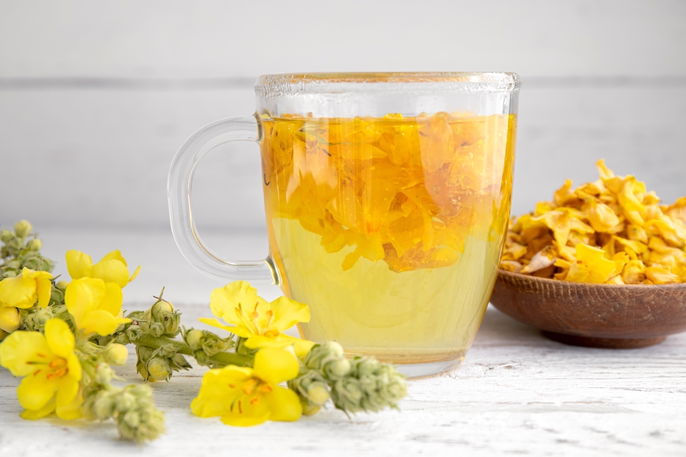Mullein is a medicinal plant that is widely used to help treat respiratory conditions, like asthma and bronchitis, as it has anti-inflammatory and expectorant properties.
The normally used parts of mullein are the flowers, leaves or roots, from which substances with medicinal properties are extracted. These parts are used to make tea, essential oil, an aqueous extract or capsules.
Mullein belongs to the Verbascum phlomoides or Verbascum thapsus species, and can be found in health food stores or pharmacies. It should be used as directed by a doctor or a medicinal plant specialist.

Health benefits
Mullein can be beneficial for the treatment of:
1. Respiratory diseases
Mullein flowers are rich in verbacosides, saponins and iridoid glycosides with anti-inflammatory and expectorant properties. It can be used to help treat respiratory diseases, such as asthma, bronchitis, spasmodic cough, tuberculosis or whooping cough.
2. Cold and flu
Mullein contains saponins, flavonoids and iridoids which naturally have anti-inflammatory and antioxidant properties, and can therefore help to fight cold and flu viruses.
It also has phenylethanoid glycosides which have antiviral properties that help eliminate viruses that cause colds and flus. It can be taken to speed-up recovery.
3. Diarrhea
Mullein can also help relieve diarrhea, gastrointestinal cramps or intestinal bleeding, due to its antispasmodic and anti-inflammatory action.
Furthermore, a lab study [1] showed that mullein contains naturally antimicrobial action against bacteria such as E. coli and Staphylococcus aureus. These bacteria typically cause intestinal infections. However, studies in humans are still needed to prove this benefit.
4. Gastritis
Mullein can help relieve symptoms of gastritis, like nausea, vomiting or stomach pain, as it has naturally anti-inflammatory, antioxidant and antispasmodic action.
5. Headache
Mullein can also be used to relieve headaches, due to its anti-inflammatory properties. It also has a sedative and calming effect.
6. Fluid retention
Mullein has diuretic action, which promotes the elimination of fluids from the body through urine and combats fluid retention.
7. Skin wounds
Mullein leaves, when used on the skin, can promote the healing of wounds, burns, bruises, phlebitis and skin infections.
Furthermore, because it has anti-inflammatory, antioxidant and emollient action, it can be used to heal, soften and protect the skin, and promote wound recovery.
8. Hemorrhoids
Due to its anti-inflammatory properties, mullein can also be applied to external hemorrhoids, helping to relieve symptoms such as pain, redness or anal itching.
Also recommended: External hemorrhoids: What They Are, Causes & How to Get Rid of Them tuasaude.com/en/external-hemorrhoids9. Rheumatic diseases
Mullein can be used to help treat rheumatic diseases, like gout, due to its anti-inflammatory and antirheumatic action. It can help to relieve joint pain.
10. Earache
Mullein essential oil can help fight earaches caused by infections like otitis.
How to use
Mullein can be used in the form of tea, aqueous extract, dressings or essential oil. These are made using the leaves, flowers or root of this plant.
1. Mullein tea
Mullein tea is one of the most commonly consumed forms of this plant. It can be made with its dried leaves to help treat respiratory illnesses, flus, colds or gastrointestinal problems.
Ingredients
- 2 tablespoons of dried mullein leaves
- 1 liter of water
Directions
Bring the water to a boil, and when it is boiling, remove from heat and add the dried mullein leaves. Allow to infuse for 10 minutes. Then strain, wait for it to cool and drink up to 3 cups of tea per day.
2. Mullein essential oil
Alcohol-free mullein flower essential oil (Verbascum thapsus) can be used to relieve ear pain.
To use mullein oil, apply 1 to 3 drops of the oil to a piece of cotton and place it in the affected ear, up to 3 times a day, or as directed by your doctor.
Preferably, you should heat the oil before applying it to your ear, being sure to test the temperature on the back of your hand to avoid burning your ear.
3. Mullein aqueous extract
Aqueous extract of mullein leaves (Verbascum thapsus) can be diluted in water and taken orally.
To prepare, add 1 to 2 mL of the aqueous extract of mullein leaves to 100 mL of water and mix well. Take up to 3 times a day. The maximum daily dose should not exceed 6 mL of the aqueous extract.
4. Mullein poultice
Mullein leaf poultice can be applied to closed, non-bleeding wounds, bruises, burns, phlebitis, skin infections or gout to promote healing.
Ingredients
- Fresh mullein leaves;
- Water.
Directions
Wash the fresh mullein leaves and add them to a container with a little water. Bring to a boil for about 5 minutes. Then, wait for it to cool, squeeze the leaves to remove excess water, and apply them directly to the affected skin or joint.
5. Mullein capsules
Mullein leaf capsules should be taken orally, with a glass of water, and doses should be advised by a doctor or herbalist, as there are capsules of various strengths.
Side effects
When taken in high doses, mullein can cause allergic reactions, leading to itching on the body, especially on the hands, arms or neck.
Contraindications
Mullein should not be used by pregnant or breastfeeding women, or by people who are allergic to this plant.
Mullein essential oil to treat earaches in children appears to be safe when used for a short time and as directed by a doctor medical advice. However, other ways of using mullein for children should be avoided, as there are not enough studies on its safety.





























